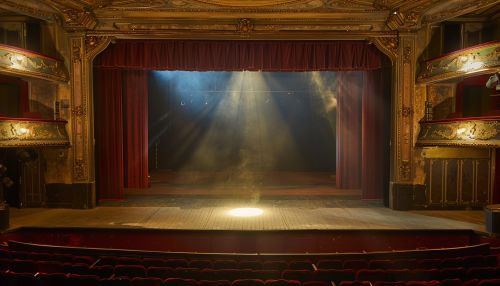Center Stage: Difference between revisions
(Created page with "== Introduction == "Center Stage" is a term that originates from the world of theater, denoting the central area of the stage where the most significant action occurs. Over time, this term has transcended its theatrical roots and is now used metaphorically in various fields to indicate a position of prominence or importance. This article delves into the multifaceted concept of "Center Stage," exploring its historical origins, technical aspects in theater, metaphorical a...") |
No edit summary |
||
| Line 7: | Line 7: | ||
The concept of center stage has its roots in ancient Greek theater, where the [[orchestra (theater)|orchestra]] was the focal point of performances. The term "center stage" itself, however, became more prevalent during the Renaissance period with the advent of proscenium theaters. These theaters featured a framed stage that directed the audience's attention to the central area, thereby establishing it as the primary locus of action. | The concept of center stage has its roots in ancient Greek theater, where the [[orchestra (theater)|orchestra]] was the focal point of performances. The term "center stage" itself, however, became more prevalent during the Renaissance period with the advent of proscenium theaters. These theaters featured a framed stage that directed the audience's attention to the central area, thereby establishing it as the primary locus of action. | ||
[[Image:Detail-91579.jpg|thumb|center|An image of a traditional proscenium theater stage with a spotlight on the center.|class=only_on_mobile]] | |||
[[Image:Detail-91580.jpg|thumb|center|An image of a traditional proscenium theater stage with a spotlight on the center.|class=only_on_desktop]] | |||
== Technical Aspects in Theater == | == Technical Aspects in Theater == | ||
Latest revision as of 15:01, 20 June 2024
Introduction
"Center Stage" is a term that originates from the world of theater, denoting the central area of the stage where the most significant action occurs. Over time, this term has transcended its theatrical roots and is now used metaphorically in various fields to indicate a position of prominence or importance. This article delves into the multifaceted concept of "Center Stage," exploring its historical origins, technical aspects in theater, metaphorical applications in different domains, and its cultural significance.
Historical Origins
The concept of center stage has its roots in ancient Greek theater, where the orchestra was the focal point of performances. The term "center stage" itself, however, became more prevalent during the Renaissance period with the advent of proscenium theaters. These theaters featured a framed stage that directed the audience's attention to the central area, thereby establishing it as the primary locus of action.


Technical Aspects in Theater
Stage Layout
In modern theater, the stage is divided into nine areas: upstage left, upstage center, upstage right, center stage left, center stage, center stage right, downstage left, downstage center, and downstage right. Center stage is the middle section of the stage, equidistant from the audience and the back wall, making it the most visible and acoustically favorable spot.
Lighting and Acoustics
Lighting plays a crucial role in emphasizing center stage. Techniques such as spotlighting and floodlighting are commonly used to draw the audience's attention to this area. Acoustically, center stage is designed to project sound evenly across the auditorium, ensuring that dialogue and music are clearly heard by the audience.
Metaphorical Applications
Business and Leadership
In the corporate world, being "center stage" often refers to taking a leading role in projects or presentations. Leaders who are center stage are those who drive initiatives, influence decisions, and are highly visible within the organization. This metaphor underscores the importance of visibility and influence in effective leadership.
Media and Entertainment
In the realm of media, center stage is synonymous with being in the spotlight. Celebrities, politicians, and public figures who dominate headlines are said to be center stage. This term highlights the role of media in shaping public perception and the importance of visibility in maintaining relevance.
Social and Cultural Contexts
In social settings, being center stage can refer to individuals who are the focus of attention in social gatherings or public events. This can be due to their charisma, achievements, or social status. In cultural contexts, center stage can denote the prominence of certain cultural practices, traditions, or movements within a society.
Cultural Significance
Symbolism in Literature and Art
The concept of center stage has been a powerful symbol in literature and art, representing themes of power, visibility, and importance. In literature, characters who are metaphorically center stage often drive the narrative and embody the central themes of the work. In visual arts, the central placement of subjects can signify their importance and draw the viewer's focus.
Psychological Implications
From a psychological perspective, the desire to be center stage can be linked to the need for recognition and validation. This can manifest in various ways, from the pursuit of leadership roles to the craving for social approval. Understanding these motivations can provide insights into human behavior and social dynamics.
